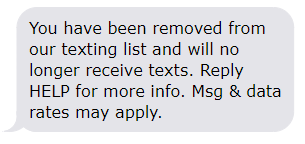When Science Gets Unexpectedly Expensive

Pictured above is a generic text message from an SMS service — if you want to stop getting messages from a store or other service, you’ll likely receive a note something like this. These messages usually end with the warning seen above: if you continue to send text messages to the service, your cell phone provider may charge you a fee for each message sent or for the data you’ve used, depending on the terms of your contract with that provider. And while many contracts allow for very high (if not unlimited) text and data use, not all do. And international data and SMS use can be even more expensive. Consumers should be careful when traveling internationally; sending a lot of texts while aboard can result in surprisingly large fees.
Just ask a bunch of Russian eagles.
In 2015, a team of Russian ornithologists began a study to learn about the migration paths of steppe eagles, an endangered species that breed in Russia, Mongolia, China, and Kazakhstan. To better understand the birds, the researchers outfitted 13 eagles with trackers; each tracker sent a message with the eagle’s location four times a day. Or, at least, that was what the team had hoped would happen. The trackers used SMS technology and, if the birds flew into regions without cell coverage, the trackers weren’t able to send any data back. The ornithologists knew about this limitation and expected to lose contact with some of the birds entirely, and similarly expected coverage gaps here and there.
What they weren’t expecting was the phone bill. In the summer of 2019, one of the birds, named Min, flew to Kazakhstan, as the birds typically did. But for months, Min stopped sending tracking data back — researchers weren’t sure if Min had died or if he had simply gone to a region without good cell coverage. Thankfully, it turned out to be the latter; in October 2019, he reappeared on their trackers. As the BBC reported, “unexpectedly, the eagle flew straight to Iran.” And all of the text messages he should have been sending during his flight? They were all still queued up to send — and all subject to international roaming fees. As the New York Times reported, “Hundreds of text messages flooded in from Min at once, each costing 49 rubles, or 77 cents — more than five times the expected price — and blowing through the project’s budget.” The total cost ran well over $1,000.
The problem was easily solved — plenty of people were willing to help pay for the bird tracking bills. Per Smithsonian, “the research team raised about $5,000 in crowdfunding to help cover the costs so they can continue tracking the eagles through the end of the [2019] and into 2020.” And they probably had the opportunity to use that money in more productive ways than SMS fees. As Smithsonian continues, the researchers’ phone company “announced that it would refund several months’ worth of charges to the project and will now offer special rates for the wayward eagles, [and] other phone companies have reached out offering free SIM cards for any new eagles the project tracks.” Efforts to protect steppe eagles — and pay their cell phone bills — are ongoing.
Bonus fact: In 1940, the United States enacted a law that gives legal protection to bald and golden eagles, helping to preserve their species. A side effect of the law was that it cut off the supply of eagle feathers (and other eagle parts) to Native Americans who would have otherwise used the feathers in various rituals. To accommodate this need, in 1994, the U.S. government created the National Eagle Repository, a processing center located outside Denver, Colorado. If any federal government agency comes across a dead eagle — whether the bird died accidentally (e.g., by flying into power lines) or the corpse was confiscated from poachers — the agency has to send the dead bird to the Repository. The Repository then sends the relevant eagle parts to Native American tribes.
From the Archives: The Cell Phone Contract Killer: An extreme way to get out of a cellular contract.
